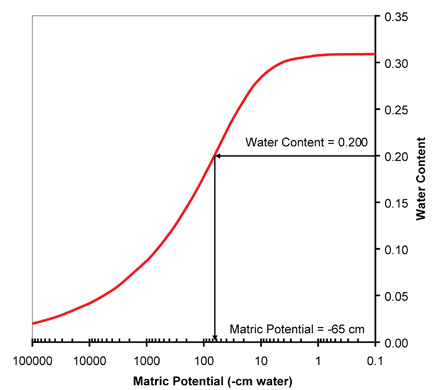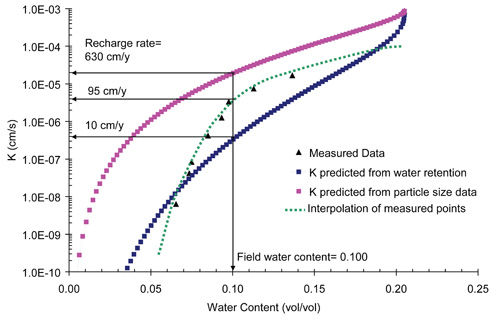

Ideally, the Darcian method for determination of point recharge rates utilizes accurately measured hydraulic conductivity
(K) at the existing field water content on core samples from a deep unsaturated zone with constant, gravity-driven flow. The steps required are:

Evaluate steadiness of flow in the field.
This is best done by measuring the matric potential profile with depth over time using instruments such as tensiometers
(Stannard, 1986; Young and Sisson, 2002) or heat dissipation probes
(Scanlon and others, 2002; see Imperial case study). Often it is only practical to determine the matric potential profile at one time (see
Palouse case study) or to measure water content with depth in lieu of matric potential.
If only water contents are measured, lab-measured (or estimated if necessary) water retention curves may be used for each type
of material within the profile to construct a matric potential profile by picking off matric potential values that correspond to the field-measured water content values (figure, left).
If water content is the only quantity measured as an indication of steadiness, in general it is necessary to do so at several times
(see New Jersey case study).
Obtain a core sample from the zone of steady flow for measurement of K.
It may be desirable, as well as economical, to install a single hole
for determination of steadiness and sample collection, therefore minimally-disturbed core samples should be collected at as many depths as possible. Disturbance
of cores during retirieval must be minimal (Hammermeister and others, 1986) as this can alter the hydraulic conductivity of the material on which recharge estimates depend.
Care should be taken to minimize evaporation from core samples (Izbicki and others, 2002) and to
weigh them as soon as possible after collection, as small
errors in field water content can translate into large errors in recharge rate (see discussion of uncertainty below).
Measure the field water content precisely.
Knowledge of the field water content within the zone of steady flow is critical to Darcian recharge
estimation and is most often (and most easily) determined gravimetrically (Topp and Ferré, 2002).
Use of a neutron probe (Hignett and Evett, 2002) or other field instruments such as TDR probes (Ferré and Topp,
2002) allows for temporal measurement of water content to assess steadiness of flow without the installation of additional holes.
In some cases, such measurements may be useful as a substitute for gravimetric determination of water content, though these instruments must have
material-specific calibrations in order to obtain adequate accuracy. In hereogeneous media it is generally advisable, and sometimes essential, to measure the water
content of the actual core sample used for K measurement. Because the K measurements are done between the time of initial weighing of the fresh sample and the time
of oven drying, it is important to carefully account for losses of matter from the core during handling and measuring.

Measure K at or near the field water content.
This step is perhaps the most costly as well as the most critical to Darcian recharge
estimation because of the extreme nonlinearity of the relationship between water content and hydraulic conductivity. It can cost several thousand dollars
to measure unsaturated hydraulic conductivity curves for a few core samples using the
Steady State Centrifuge Method (Nimmo and others, 2002) or other laboratory methods
(Klute and Dirksen, 1986). Additionally, measured
data often must be interpolated as many measurement techniques allow for a priori choice of K but not water content. For these reasons,
unsaturated hydraulic conductivity curves are sometimes estimated using pedotransfer functions, though this can increase uncertainty
to the point where the estimated recharge rate is so poorly known as to have no hydrologic value. The diagram at the right shows differences in recharge rates obtained using measured and estimated
hydraulic conductivity curves. The estimated curves may lead to errors of a factor of 10 or more.
Evaluate uncertainty in measurements.
There are errors associated with 1) measurement of field water content, 2) measurement of matric
potential profiles, 3) deviations from the ideal of the uniform matric potential and steadiness of flow, and 4) measurement or estimation of hydraulic
conductivity. These errors must be quantified individually as well as in conjunction in order to be certain that the determined recharge estimate is sufficiently
accurate for the intended purpose. Errors in field water content can be assessed by taking replicate samples to extrapolate evaporation or by taking
additional field measurements. This error can be very large where K has a strong dependence on q. Error in
matric potential and K must be evaluated based on the device or technique used in the measurement. For instance, field probes often have known associated errors, such as ± 2.5% for TDR probes or ± 100 cm-water for
heat dissipation probes. Nimmo and others (1994) estimated uncertainty of 6-20% in K for the SSC method.
Critical issues that occur with proposed application in a new location:
- What UZ depths do measurements need to come from?
- Can K be estimated rather than measured?
- What can be done where steadiness of flow is only seasonal or otherwise imperfect?
- How does uncertainty in K, matric potential, and field water content translate to uncertainty in recharge rate?
Case Study Sites
For more information contact: UZ Flow Webmaster
Last modified: Fri Feb 24 09:09:27 PDT 2006





